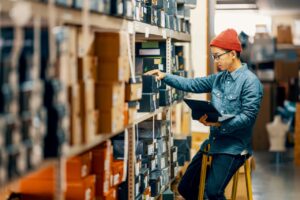
What unified commerce means for specialty retailing
In today’s digital world, specialty retailers are struggling to keep pace—with both the changing speed of technology innovation and the changing expectations of consumers. All our new shopping channels have catapulted the need for a unified commerce experience, one that puts customer-centricity at the center.
With unified commerce, retailers can blend the digital and physical and provide shoppers with a seamless, personalized and enhanced experience as they move from online to mobile to in-store, and back again. And without the retailer worrying about how and where an order’s fulfillment will take place.
Sounds great, right?
Unfortunately, the reality is that most retailers, especially specialty stores, lack the ability to provide this level of service today because of the traditional legacy systems they are using. While they are able to transact through multiple channels, they do not use one piece of software to do so, leading to multiple versions of the truth.
When you analyze the challenges related to providing a seamless experience to customers, two clear perspectives are evident: the customer’s and the retailer’s. A solution must address both. Let’s take a look at each of their needs and what’s important in today’s evolving retail industry.
Meeting the needs of your customers
- The In-Store Experience. Customers visit a brick and mortar location expecting a differentiated experience. The feel of the store can light up the shopper’s senses and provide stickiness, but only if they are able to augment or best the experience they already have online. Here are some areas for consideration:
- Digital Signage: Personalized digital signage is an attractive way to show customers products that are relevant to them.
- Product availability: For physical stores to be relevant, they need to carry the right product assortment with alternative options. It is estimated that on average roughly 8% of the items a customer wants to buy are absent on the shelf. For a third consecutive out-of-stock (OSS) time, only 30% of customers will look for an in-store substitute while 70% will move to a different store.[1]
- Showrooming: Customers want to touch the product or try it.
- Endless aisle: Having the ability to shop beyond the walls of the store with their choice of home delivery or shipment to the store.
- Buy Anywhere/Pickup Anywhere. Sometimes, people want to be able to start a transaction on their phones and finalize it in the store. They may also want one of the items in the transaction shipped to their house while the rest are picked up from the physical store. They expect this to be totally seamless, without any friction.
- Product information. Shoppers want product information and the ability to compare everywhere. When combining catalog with customer and past purchase information, the knowledge provided becomes relevant and easily consumable.
- Preferential/Personal Pricing. Frequent shoppers want to see preferential pricing, preferably before they get to the point when they must pay.
- Assisted Sales. Shoppers want well-trained and knowledgeable staff who can help them.
Meeting the needs of your business
Customer Experience. Shoppers today have higher expectations and want to engage with retailers seamlessly across multiple channels, anytime, anywhere.
- Technologies like sensors, beacons, RFID, additional cameras, and wireless networks are required to make a frictionless store work. These can greatly benefit both Marketing and Merchandising by providing information about how consumers navigate the store, traffic patterns and dwell time.
- These technologies can also help provide customers with valuable product information when they want it, in an unobtrusive way. For example, a retailer can detect when a shopper is viewing specific items and offer a targeted discount.
- Inventory Efficiency.
- Stockout: Retail out-of-stocks cost the industry billions every year. In North America, annual loss from OOS is $129.5 billion[2]. Having a real-time view of the inventory is not enough. The solution must be able to take a multitude of data points both internal and external to accurately forecast.
- Right Assortment: Knowing what products are cannibalizing sales and which are promoting related sales are key when optimizing inventory and improving profits.
- Labor Efficiency. Churn rates are extremely high in Retail. Solutions must be designed with ease of use in mind. They should also allow employees to switch tasks seamlessly, such as going from cashier to assisted sales.
- Loss Prevention. Cameras and some of the same technologies used to address the customer experience can also improve loss prevention. Digital surveillance and transaction analytics can be combined to identify irregularities including inventory inconsistencies or the instance of “sweethearting.” Estimates put average inventory shrink at 1.38 percent of retail sales, or $45.2 billion in 2015, up by $1.2 billion from 2014.[3]
Achieving customer-centricity across the shopping journey
As we evolve from omni-channel to unified commerce, all the channels are connected in real time providing only one version of the truth. Furthermore, the customer can truly be placed at the center of the retailer’s business. Customers are no longer satisfied that online shopping is a better experience because of the rich catalog, ease of use, smart comparisons and advice it offers. New cloud-based solutions can provide a seamless and rich customer experience across all channels.
Microsoft Dynamics 365 was created to help retailers achieve the next level of customer centricity and service, with more personalized interactions supported by machine learning, analytics and the cloud. It also runs across devices—from cash registers to tablets—for seamless inventory management, and retail operations and information sharing to deliver amazing experiences to customers in this industry of constantly changing demands.
The commerce runtime (CRT), at the heart of the solution, serves as the engine for retail channels. This expedites time-to-market, provides consistency, and guarantees that each shopper is recognized regardless of the channel they are using. Because the CRT is the same across channels, all discounts, promotions, rules, and restrictions apply whether they are at the store or buying from their phone.
Microsoft also understands that the Internet speed and reliability has increased significantly over time, truly enabling scenarios where servers in the physical stores are no longer required. With that in mind, this solution can reside purely in the cloud. The points-of-sale clients can run as a modern application or in a browser, further simplifying deployment.
Quick study: learning from success
There are a number of great examples of specialty retail leaders using Microsoft Dynamics 365 to move to a more unified approach and take advantage of its many benefits.
Hickory Farms, for example, made the move to Microsoft Dynamics 365, replacing four disparate legacy business systems to integrate its catalog and mail order, web, retail, and wholesale operations into a single platform. The company can now benefit from increased 360-degree supply chain visibility, including inventory and customer information; omnichannel order and cross-channel fulfillment functionality, including buy, pickup, return, and ship to and from anywhere; and position the company for growth.
Other specialty retailers like Saje Wellness, Pet Supplies Plus and Guy Degrenne are also using Microsoft Dynamics and cloud services to achieve one source of truth, streamline business processes and boost performance, provide better customer service, and support their ambitious growth plans.
To learn more, try a Guided Tour.
LinkedIn: Hayan Ortega
Twitter: @hayan_ortega
[1] http://eknresearch.com/2016/12/22/plugging-stock-gaps-consumer-goods-2/
[2] http://www.retailwire.com/discussion/retailers-suffer-the-high-cost-of-overstocks-and-out-of-stocks
[3] https://nrf.com/media/press-releases/retail-inventory-shrinkage-increased-452-billion-2015








